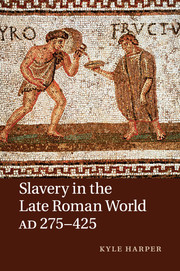Book contents
- Frontmatter
- Contents
- List of tables
- Acknowledgments
- PART I THE ECONOMY OF SLAVERY
- PART II THE MAKING OF HONORABLE SOCIETY
- PART III THE IMPERIAL ORDER
- Introduction
- 9 Citizenship and civil conflict: slave status after the Antonine Constitution
- 10 The enslavement of Mediterranean bodies: child exposure and child sale
- 11 The community of honor: the state and sexuality
- 12 Rites of manumission, rights of the freed
- CONCLUSION
- APPENDIXES
- Bibliography
- Index
12 - Rites of manumission, rights of the freed
Published online by Cambridge University Press: 05 August 2011
- Frontmatter
- Contents
- List of tables
- Acknowledgments
- PART I THE ECONOMY OF SLAVERY
- PART II THE MAKING OF HONORABLE SOCIETY
- PART III THE IMPERIAL ORDER
- Introduction
- 9 Citizenship and civil conflict: slave status after the Antonine Constitution
- 10 The enslavement of Mediterranean bodies: child exposure and child sale
- 11 The community of honor: the state and sexuality
- 12 Rites of manumission, rights of the freed
- CONCLUSION
- APPENDIXES
- Bibliography
- Index
Summary
THE LATE ANTIQUE EQUILIBRIUM: BETWEEN CHURCH AND STATE
On Easter day in 379, Gregory of Nyssa delivered a homily in which he described the atmosphere of joy and celebration which suffused the holiest day of the Christian calendar in late antiquity. The roads were empty, he declared, and the fields left without workers. All came to church in honor of the resurrected Christ. Indeed, in his native Cappadocia, it was unusual to see all of society's elements gathered together:
The wife with the full complement of the household rejoices in celebration. The husband and the children and the slaves and all who share the hearth rejoice. Just like a swarm of bees that is newly born, away from the beehive for the first time in the air and the light, jointly clusters upon the branch of a tree, in the same way on this festival all the generations of the household run together to the hearth.
The presence of the “full complement of the household,” including the mistress and the slaves, made the communal gathering at Easter exceptional. The attendance of slaves was more than just decoration for the family on a public holiday, although it was that too. The paschal season accrued a broad ritual importance in early Christianity, and in late antiquity the sacred liturgy absorbed a rite with tremendous secular importance, the manumission of slaves.
- Type
- Chapter
- Information
- Slavery in the Late Roman World, AD 275–425 , pp. 463 - 494Publisher: Cambridge University PressPrint publication year: 2011



